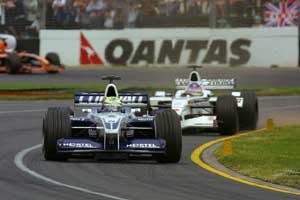Features - News Feature
MARCH 21, 2001
Safety back under the microscope
BY DAVID TREMAYNE

The tragic accident on the fifth lap of the Australian GP has again focused attention on the need to ensure that race officials and spectators enjoy the same levels of protection as the drivers at F1 races. The death of track marshal Graham Beveridge during the Australian Grand Prix in Melbourne has once again placed sharp focus on the safety repercussions when wheels become detached from racing cars.
Investigations at the Albert Park track confirmed that the right rear wheel of Jacques Villeneuve's BAR-Honda was torn off as the car spun violently into the safety fences on the 220 kph approach to the third corner, following the French-Canadian's collision with Ralf Schumacher's BMW Williams on the fifth lap. By a freak chance the errant wheel went through an access hole cut in the chainlink fence before striking the 51 year-old Queensland man in the chest.
The incident had harrowing parallels with the four-car accident at Monza last year in which a wheel detached from Heinz-Harald Frentzen's Jordan was fired violently to the left of the circuit at the second chicane, and struck and killed marshal Paolo Ghislimberti.
On the fateful weekend at Imola in 1994, when Roland Ratzenberger and Ayrton Senna were killed, a collision on the startline between Pedro Lamy's Lotus and JJ Lehto's Benetton resulted in a wheel being thrown over a grandstand and hitting a policeman. That prompted the FIA to investigate means of preventing wheels from being torn off completely. The multi-car accident at the start of the 1998 Belgian GP gave the investigation further impetus, and led directly to the introduction of wheel tethers for the 1999 season. These are steel cables designed to prevent wheels flying off by linking the wheel hubs to the chassis.
Peter Wright, the former technical director of Team Lotus who is now the technical delegate of the FIA, believes that the tethers are the biggest safety step that F1 has taken in the last decade, even though circumstance sometimes dictates, as in Melbourne, that they do not always work.
"It was just pure statistics with the amount of wheels bouncing around, that sooner or later one was going to hit something," Wright says. "At the end of the day the last driver to be killed in F1, Senna, was because of a wheel and suspension component." Sadly, the same holds true for the two marshals.
|
"We were incredibly lucky at Spa in 1998, because somebody was killed by an errant wheel in a minor race there a year later. It happens. You've only got to look at what happened on the exit to the La Source corner on that occasion; with the number of wheels flying around it was pure luck that somebody didn't get hit."
In light of the recent tragedy it is ironic that wheel tethers first proved their worth in Albert Park two years ago when Mika Hakkinen lost control of his McLaren in practice. The car sustained heavy suspension damage on all four corners, after hitting the wall on the exit to the final corner. But all four wheels stayed attached and the spectating public was suitably protected. Later that year there were concerns that the tethers were causing serious damage to the chassis in really heavy impacts, so the engineers had a rethink.
"The tethers have 5000 kg (1 ton) breaking strain, and you can generate forces greater than that, never mind any cutting action," Wright explains. "So under certain circumstances they are going to fail, and there's not much you can do about that. If you trap a wheel against a barrier or something, and then drag it, you are basically not going to stop the car from tearing it off itself. Using two tethers makes lots of sense, so that's what we did for 2000. The trouble is deciding where the tethers should yield."
Now the first tether breaks at 5000 kg, the second at 10,000, providing a belt and braces form of protection. Breakage of the first absorbs a lot of energy, and gives the second, which in any case is stronger, a much better chance of remaining intact. But, as Monza proved last year, and Albert Park again last weekend, situations can still arise when even a breaking strain of 10,000 kg is not enough.
The other concern is the manner in which Villeneuve's car took off after striking the back of Schumacher's. Only luck prevented the car clearing the safety fencing and landing in the crowd. After a similar accident with David Coulthard at Spa in 1999, Australian GP winner Michael Schumacher called for an increase in the width of the mandatory deformable structure at the rear of the cars, to prevent a recurrence. Such calls are likely to be repeated.
Williams' technical director Patrick Head agrees with longtime safety campaigner Jackie Stewart that greater protection is required for officials and spectators.
"You've got to ask if the marshal had proper protection where he was standing because if you have open wheel racing cars, it does not matter what you do about tying bits to them," Head said.
"I think the marshals will have to have more robust protection around them. There is no need to have a man with a flag out there - you can have a button to push with an arm that can come out with a flag on it."
Stewart said: "We have got to do even more than we have done so far about tying the wheels together. We need to do it even for wings and so forth. At 200 or 300 kph, you just don't know where that type of debris is going to go."